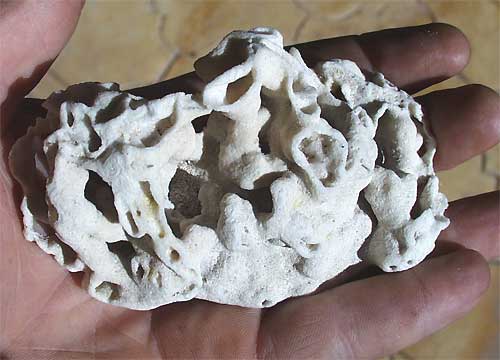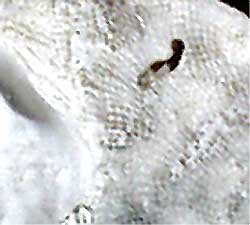Excerpts from Jim Conrad's
Naturalist Newsletter
from the January 22, 2006 Newsletter written at Hacienda San Juan Lizárraga
one kilometer east of Telchac Pueblo, Yucatán, MÉXICO
and issued from Hotel Reef Yucatan 13 kms to the north
BRYOZOA ON THE BEACH

Occasionally on the beach I find white, rocklike, oddly formed items most often just a couple of inches across. Until now I've assumed that they were pieces of coral washed ashore. This week I came upon such a pretty piece that I had to examine it more closely. You can see it above.
 Two features of the item made me wonder whether it really was coral. First, in several places the item was sheetlike, and the thin, overlapping sheets had clearly grown onto and around some seashells, embedding the shells within the structure's matrix. Second, even the naked eye could see that the sheets were composed of many rectangular, contiguous cells systematically arranged like cells in wood. This didn't look like coral at all. You can see a close-up of the cellular structure and how a seashell was embedded in the matrix at the right.
Two features of the item made me wonder whether it really was coral. First, in several places the item was sheetlike, and the thin, overlapping sheets had clearly grown onto and around some seashells, embedding the shells within the structure's matrix. Second, even the naked eye could see that the sheets were composed of many rectangular, contiguous cells systematically arranged like cells in wood. This didn't look like coral at all. You can see a close-up of the cellular structure and how a seashell was embedded in the matrix at the right.
With some Googling on the hotel computer I realized that indeed it wasn't coral, but rather something known as calcareous bryozoa. Well, that set off a flurry of studying and figuring out. Here's part of what I learned:
When on the beach you find white, rocklike chunks of either bryozoa or coral, you're finding the remains of colonies of tiny animals, with the animals now dead and gone. Cells of the individual tiny animals are cemented to one another mostly with calcium carbonate (the same as limestone). The individual tiny CORAL animal is referred to as a polyp while the bryozoa unit is called a zooid. A discussion of the differences between coral and bryozoa can be reviewed at http://www.bio.umass.edu/biology/conn.river/corals.html.
And there are big differences. Corals and bryozoa are in completely different taxonomic phyla. You can grasp the significance of that when you realize that all animals with backbones -- birds to fish to mice and humans -- belong to the same phylum. Thus there's more difference between a coral polyp and a bryozoa zooid than between a hummingbird and a hippopotamus.
The individual bryozoa zooid, though tiny, is much more complex and highly evolved than a coral polyp. A typical zooid looks like a tiny, upside-down octopus on a stem. A nice diagrammatic illustration showing one, and how its cell connects to neighboring cells, is at http://www.civgeo.rmit.edu.au/bryozoa/bryointr.html
I first heard about bryozoa when taking geology classes in college. The bedrock of much of central Kentucky and Tennessee, as well as other large areas of North America, is composed of limestone in which fossil bryozoa are often abundant, sometimes constituting most of the rock itself. Typical bryozoa fossils clearly show the flat sheets of tiny, highly ordered, rectangular cells seen in my beach specimen.
Not all bryozoa species are marine with their zooids cemented together into colonial, rocklike structures. Some species live in freshwater and some bore into calcareous substrates such as limestone instead of secreting their own shells. See a taxonomic overview of past and present bryozoa types at http://www.ucmp.berkeley.edu/bryozoa/bryozoasy.html.
Of course there were no elegant little bryozoa zooids in the chunk of white calcium carbonate I found this week on the beach. What I had was like a city block of abandoned houses in an abandoned city. Who knows what disaster had caused it to be lying there instead of being home to a thriving community of pretty zooids in the Gulf's warm, shallow waters?